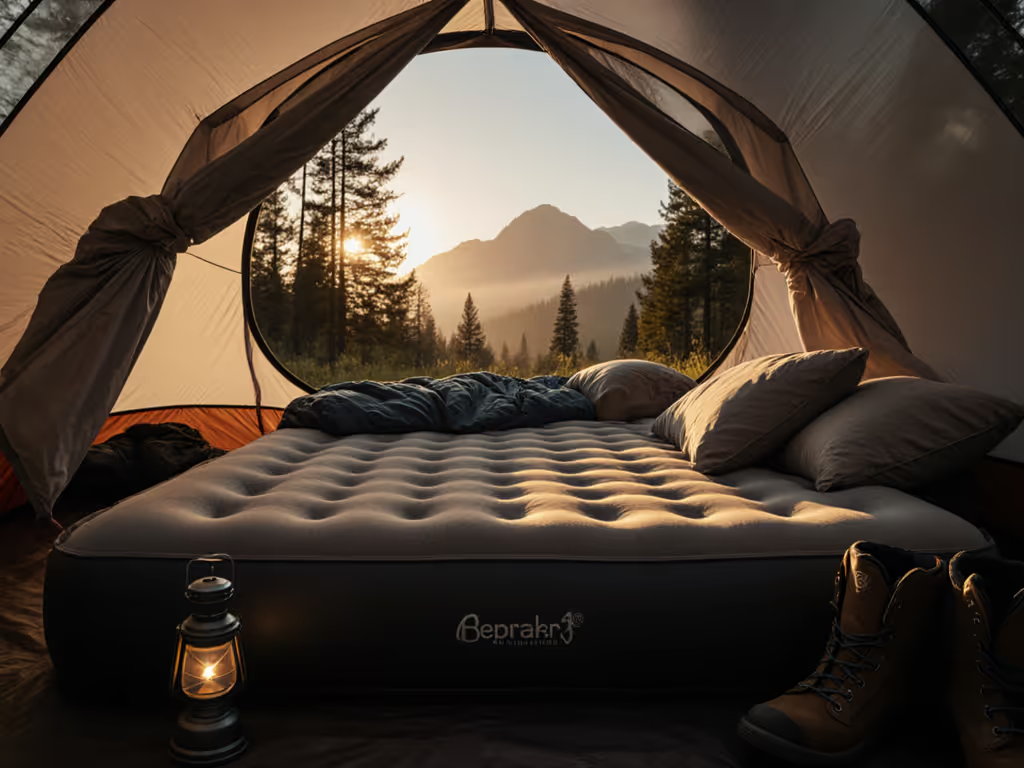
How to Choose Fold Chairs That Won’t Ruin Your Camping Setup: The Essential Camper’s Checklist
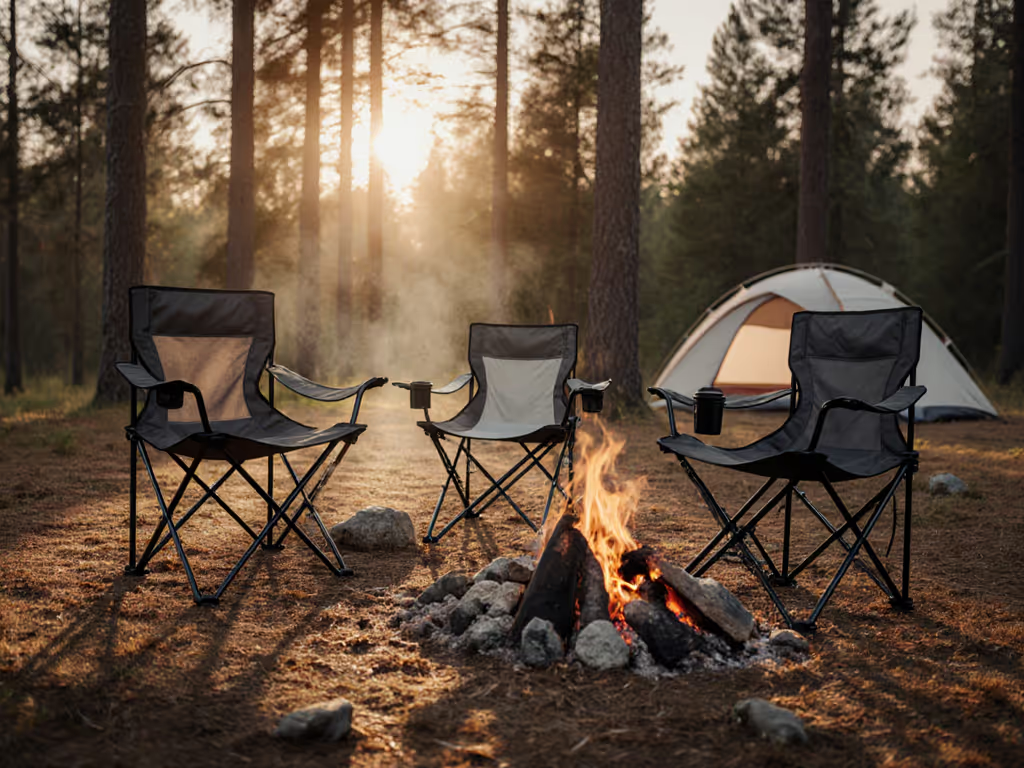
Pick the wrong fold chairs and the ripple effects show up fast: wobbly meals, sore backs, and a campsite that feels more chaotic than cozy. The good news is that your comfort is not guesswork; it is geometry, materials engineering, and a touch of systems thinking. In the next few minutes, you will learn how to match seat height to table height, choose frames that resist flex, and pack kits that set up in minutes. To make it effortless, we will lean on insights from Camper Loadouts, the team known for chair and table pairing guides and for providing guidance on cohesive glamping setups. Ready to end rushed camp dinners and unstable seating forever? Let us start by decoding the measurements that make or break your experience with fold chairs. For a deeper dive into seat angles and posture, see our camp chair geometry guide.
The Geometry That Makes or Breaks Camp Comfort
You do not need a tape measure obsession to sit well, but you do need three numbers: seat height, table height, and seat-back angle. Most campers feel best when their thighs run parallel to the ground, knees at roughly 90 degrees, and forearms float comfortably above the tabletop. That means aligning seat height to table height with a predictable gap. Aim for about 28-32 cm (centimeters) of difference for full-height dining, with a slightly smaller gap for low-slung lounge tables. Why does this matter? If the seat sits too low relative to the table, you hunch and fatigue your shoulders; too high, and your thighs press into the edge, limiting circulation. Camper Loadouts quantifies these fits across common chair and table categories available on the market, so you can choose fold chairs that match your preferred meal posture and play posture in one go.
Stability matters just as much as height. A wide base, slightly reclined back angle of 100-110 degrees, and a firm seat pan create that “set-and-forget” feeling. Add adjustable feet for uneven terrain and you dramatically reduce tipping moments when someone leans or passes a pot. Visualize a simple diagram: a triangle drawn from your hips to your heels and up to the chair’s back. When that triangle is broad and the back angle hovers just past upright, you gain support without feeling trapped. Camper Loadouts’ data-driven guides map these angles and base widths to specific use cases, helping you select fold chairs that are likely to work well with your table, cots, and organizers.
Key Fit Targets for Common Camp Activities
| Use Case | Seat Height | Table Height | Seat-to-Table Gap | Back Angle | Notes |
|---|---|---|---|---|---|
| Dining | 43-48 cm (centimeters) | 72-76 cm (centimeters) | 28-32 cm (centimeters) | 100-105 degrees | Encourages upright posture for eating and games. |
| Lounge / Fire Pit | 28-38 cm (centimeters) | 45-55 cm (centimeters) low table | 15-20 cm (centimeters) | 105-110 degrees | Relaxed hip angle and stable, wide base recommended. |
| Fishing / Shoreline | 35-45 cm (centimeters) | Side tray 55-65 cm (centimeters) | 10-15 cm (centimeters) | 100-110 degrees | When shopping, look for models with mud feet and rod-holder options. |
| Glamping Breakfast | 45-50 cm (centimeters) | 74-78 cm (centimeters) | 28-33 cm (centimeters) | 100-105 degrees | Prioritize armrests and lumbar support. |
Fold Chairs 101: Types, Trade-offs, and Use Cases
Not all fold chairs are built for the same moment. Director-style chairs offer great leverage for standing up, thanks to rigid armrests and a higher seat pan. Low-slung camp loungers cradle you at the fire, but they rarely pair well with standard-height tables. Rockers soothe sore backs yet demand flat ground. Ultralight designs save pack space, at the cost of narrower bases and more flex. Learn how weight savings trade off with stability in our ultralight vs comfort chair guide. There is no single winner; there is only the right match for your table height, terrain, and trip rhythm. This is where Camper Loadouts excels, comparing fishing-specific chairs with side trays versus compact car camping seats that collapse into narrow cases, and then recommending the best pairings for your cooking and dining kit.
Watch This Helpful Video
To help you better understand fold chairs, we've included this informative video from Smart Design. It provides valuable insights and visual demonstrations that complement the written content.
Think of each chair as a bundle of variables: frame material, seat tension, footprint, and feature set. Aluminum (with aluminum written as Al (aluminum) if abbreviated, but we will keep full name here) frames resist rust and keep weight low, while steel boosts stiffness for bigger folks or windy sites. Mesh panels improve breathability and dry time after a squall. Cup holders are nice; arm height is crucial. If the armrests sit too high, your shoulders creep upward; too low and you slump. A chair’s footprint also defines stability: wider is safer on sand and duff, while narrow feet sink less into soft lawns. Camper Loadouts’ comparisons go beyond marketing claims, measuring exact base widths and seat tensions so your fold chairs feel anchored instead of fussy.
Common Fold Chair Types Compared
| Type | Typical Seat Height | Stability | Pack Volume | Best For | Watch Outs |
|---|---|---|---|---|---|
| Director Chair | 45-50 cm (centimeters) | High | Medium | Dining, food prep, glamping | Can feel boxy at the fire pit. |
| Low Lounge Chair | 28-35 cm (centimeters) | Medium | Low | Fire-side lounging, stargazing | Poor match for full-height tables. |
| Ultralight Trek Chair | 32-40 cm (centimeters) | Medium | Very Low | Hike-in picnics, compact car trunks | Narrow feet can sink into sand. |
| Folding Rocker | 42-47 cm (centimeters) | Medium | High | Back relief, campfire relaxation | Requires flat ground for safe rocking. |
| Fishing Platform Chair | 38-45 cm (centimeters) | High | Medium | Angling, bank or dock use | Adds weight; bring mud feet or leveling legs. |
The Essential Camper’s Checklist: Measurements, Materials, and Mechanics
When you evaluate fold chairs, do it with a checklist you can trust in any aisle or review page. Start with measurements: seat height, back angle, armrest height, base width, and packed size. Then materials: powder-coated steel for ruggedness, aircraft-grade aluminum for low weight, and UV-resistant polyester seat fabrics to avoid sun rot. Finally mechanics: cross-brace action for rigidity, quiet bushings that do not squeak, and hinge pins that are easy to service. If you have ever rushed through dinner because the chair-pinched your legs under the table, you already understand how small mismatches add up. Camper Loadouts bakes this into their pairing guides, helping ensure your chair matches your existing table within ideal seat-to-table gaps and armrest clearances.
Use this quick, field-ready checklist the next time you shop or pack:
- Measure your table height in cm (centimeters) and target a seat-to-table gap near 28-32 cm (centimeters) for dining.
- Check base width. Wider bases resist side-sway in wind and on uneven ground.
- Sit-test armrest height. You want neutral shoulders and relaxed elbows.
- Look for replaceable feet, serviceable hinges, and reinforced seat corners.
- Confirm packed dimensions fit your trunk and do not block cooler access.
- Match features to your activity: rod holders for anglers, side tables for long breakfasts, mesh for humid climates.
Material and Hardware Signals of Durability
| Component | Better Choice | Why It Matters |
|---|---|---|
| Frame | Powder-coated steel or anodized aluminum | Resists corrosion and surface wear in wet or salty air. |
| Fabric | 600D polyester or ripstop nylon with UV treatment | Balances abrasion resistance with quick dry after rain. |
| Feet | Articulated, wide “mud feet” | Spreads load on sand, prevents sinking and tipping. |
| Hinges | Metal pins, serviceable bushings | Reduces squeak and play; extends life with lubrication. |
| Armrests | Padded, rigid with rounded edges | Comfort for long sits and easier stand-ups. |
Packability, Weight, and Setup Time: Planning for Real Trips
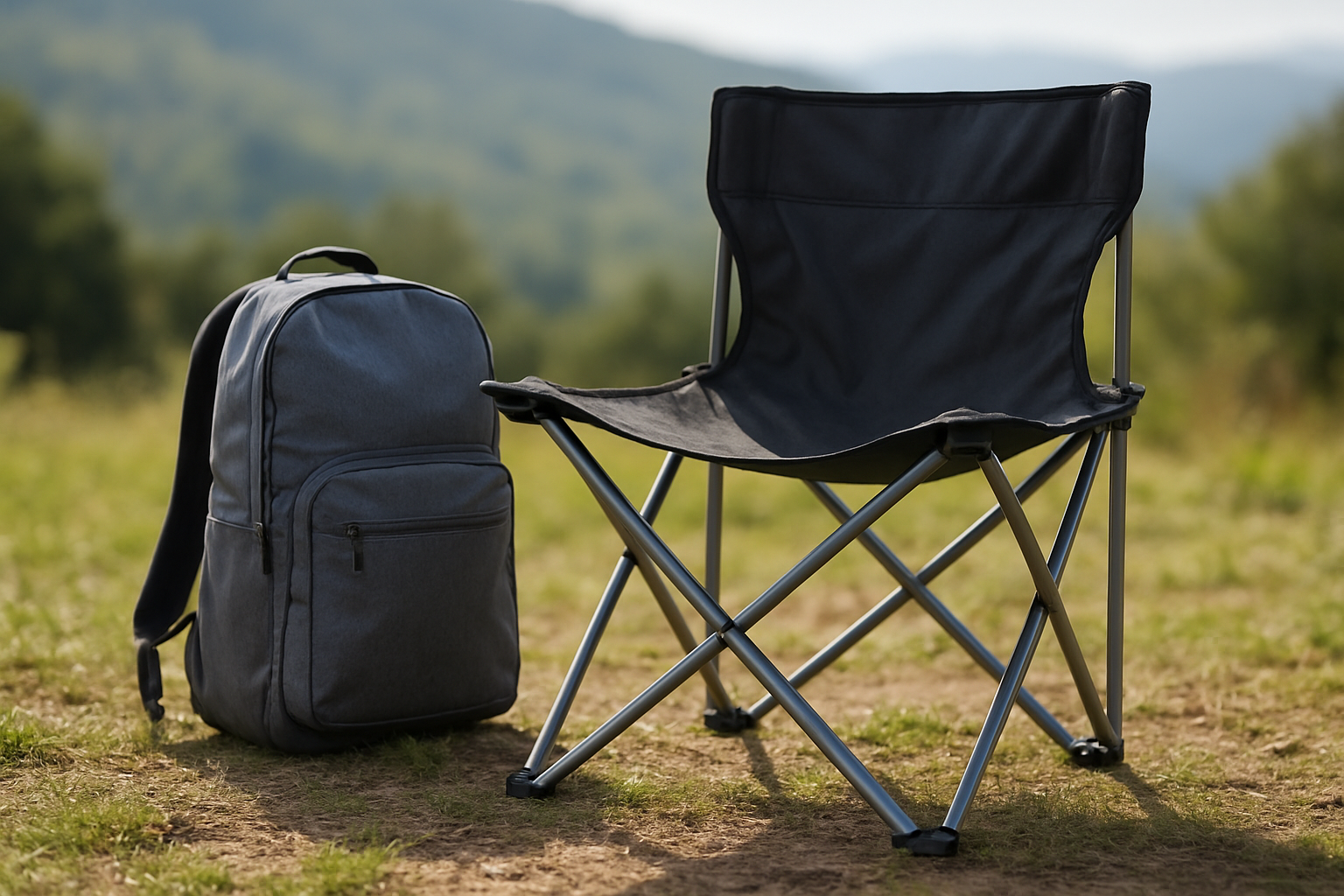
It is easy to fall in love with a plush chair in a showroom, only to find it eats half your trunk space and steals time from hiking. If storage is tight, explore our space-saving camp furniture solutions. Consider the three variables that actually shape your weekend: pack volume, carry weight, and setup time. For car camping, a chair that packs to a slim rectangle can slide beside bins and stoves, preserving your cooler’s top access. For hike-in picnics or festivals, every 0.5 kg (kilograms) counts. And for family trips, shaving two minutes off each setup task adds up to an extra hour of play. Industry field tests suggest that campers are twice as likely to linger after meals when their seats and table fit well, which is a simple way to convert gear into memories. Camper Loadouts quantifies these trade-offs so your fold chairs earn their keep across trips.
Try building a “kit profile” before you buy. How many seats do you usually pack? How often do you move camp? Which bin do the chairs live in? A compact chair that assembles in 90 seconds can be the difference between a leisurely sunset and a race against dusk. A heavier director chair you never mind lifting might still be worth it if the base is rock-solid and the armrests help grandparents rise. The goal is not minimalism for its own sake; it is a balanced system. With chair and table pairing guides and a focus on measured pack volume, Camper Loadouts helps you hit that balance for fold chairs without guesswork.
Example Kit Profiles and Packing Metrics
| Profile | Per-Chair Weight | Packed Size | Setup Time | Best For |
|---|---|---|---|---|
| Ultralight Pair | 0.9-1.4 kg (kilograms) | 40 x 12 x 12 cm (centimeters) | 60-90 seconds | Short walks from car, picnic hikes |
| Compact Car-Camp | 2.5-3.6 kg (kilograms) | 76 x 15 x 50 cm (centimeters) | 30-45 seconds | Weekends with a full trunk |
| Comfort First | 4-6 kg (kilograms) | 95 x 20 x 55 cm (centimeters) | 15-30 seconds | Glamping, long meals, board games |
| Angler’s Rig | 4-5 kg (kilograms) | 85 x 20 x 50 cm (centimeters) | 60-90 seconds | Fishing with gear trays and rod support |
Real-World Scenarios: Case Studies from the Field
A car-camping family upgraded from a mix of yard chairs to matched director chairs and a 74 cm (centimeters) table. Before the change, dad hunch-sliced vegetables while kids perched on wobbly stools. After matching seat and table heights using Camper Loadouts’ chair and table pairing guides, the meal window doubled from 20 to 40 minutes, according to their weekend notes. Shoulder soreness went away for the primary cook, and games lasted longer because forearms could rest comfortably on the tabletop. The unseen win was packing: the new chairs nested edgewise next to storage totes, cutting trunk repacking time by 10 minutes.
An angler who bounced between piers and riverbanks swapped a lounge chair for a fishing-specific platform seat with mud feet and a side tray. The older chair sank into gravel and twisted under load; the new one offered a wider base and a slightly higher seat pan. With a 12 cm (centimeters) shorter reach to the lure tray, the number of casts per hour rose. That small ergonomic change kept core fatigue low, and the chair’s quick-adjust feet saved time every time the ground changed. Camper Loadouts’ fishing-specific chair comparisons spotlight these details so your fold chairs stay stable while you focus on the water. Start with our best camping chairs for anglers for stability, storage, and shoreline comfort.
On the glamping side, a couple outfitted a canvas tent with coordinated chairs, a folding bistro table, and a low coffee table for the fire pit. By pairing two chair heights and two table heights on purpose, mornings were upright and social, evenings were loungy and stargazer-friendly. The chairs shared a fabric palette and armrest style, creating visual harmony. But the magic was modularity: everything packed flat into a single trunk bay, and each item worked with the others without shims or improvisation. This is the Camper Loadouts approach: guidance for cohesive glamping furniture setups that feel curated, not cobbled together from mismatched fold chairs.
How Camper Loadouts Helps You Pair Chairs and Tables Like a Pro
Most camping discomfort is not about foam thickness; it is about mismatched geometry and fussy setups. Camper Loadouts solves this by providing data-driven guides that match chairs, tables, cots, and organizers so each piece supports the others. Their process starts with measurement: actual seat heights, base widths, and back angles, plus table heights and overhangs. They evaluate pack volume in cubic centimeters (cm³ (cubic centimeters)) and setup time with repeatable tests. Then they translate it into clear recommendations, often with two or three viable configurations to suit different vehicles and group sizes. You end up with fold chairs that align with your table and a kit that packs like it was meant to, because it was selected as a system.
Beyond the numbers, Camper Loadouts leans into real-world use. For car campers, they suggest ergonomic upgrades like shoulder-friendly armrests and seat tensions that distribute weight evenly. For anglers, they compare fishing-specific chairs with rod holders, side trays, and leveling feet, so your platform stays true on rip-rap. For makers, their do-it-yourself (DIY) wilderness furniture builds show how to fabricate low tables that pair with lounge-height chairs and how to add wide feet to your existing seat. The result is a smoother weekend: fewer shimmies under chair legs, fewer cold meals, more time sinking into scenery. When you tune the details, fold chairs stop being a wildcard and start being a foundation.
- Chair and table pairing guides: find the right seat-to-table gap by activity and body size.
- Guides for cohesive glamping setups: coordinated heights, finishes, and pack shapes.
- Car camping accessories and ergonomic upgrades: armrests, lumbar tweaks, and smarter storage.
- Fishing-specific comparisons: stable bases, mud feet, and tray reach analysis.
- DIY (do-it-yourself) builds: practical, field-tested designs with cut lists and adjustment tips.
Choosing Fold Chairs That Actually Fit Your Table
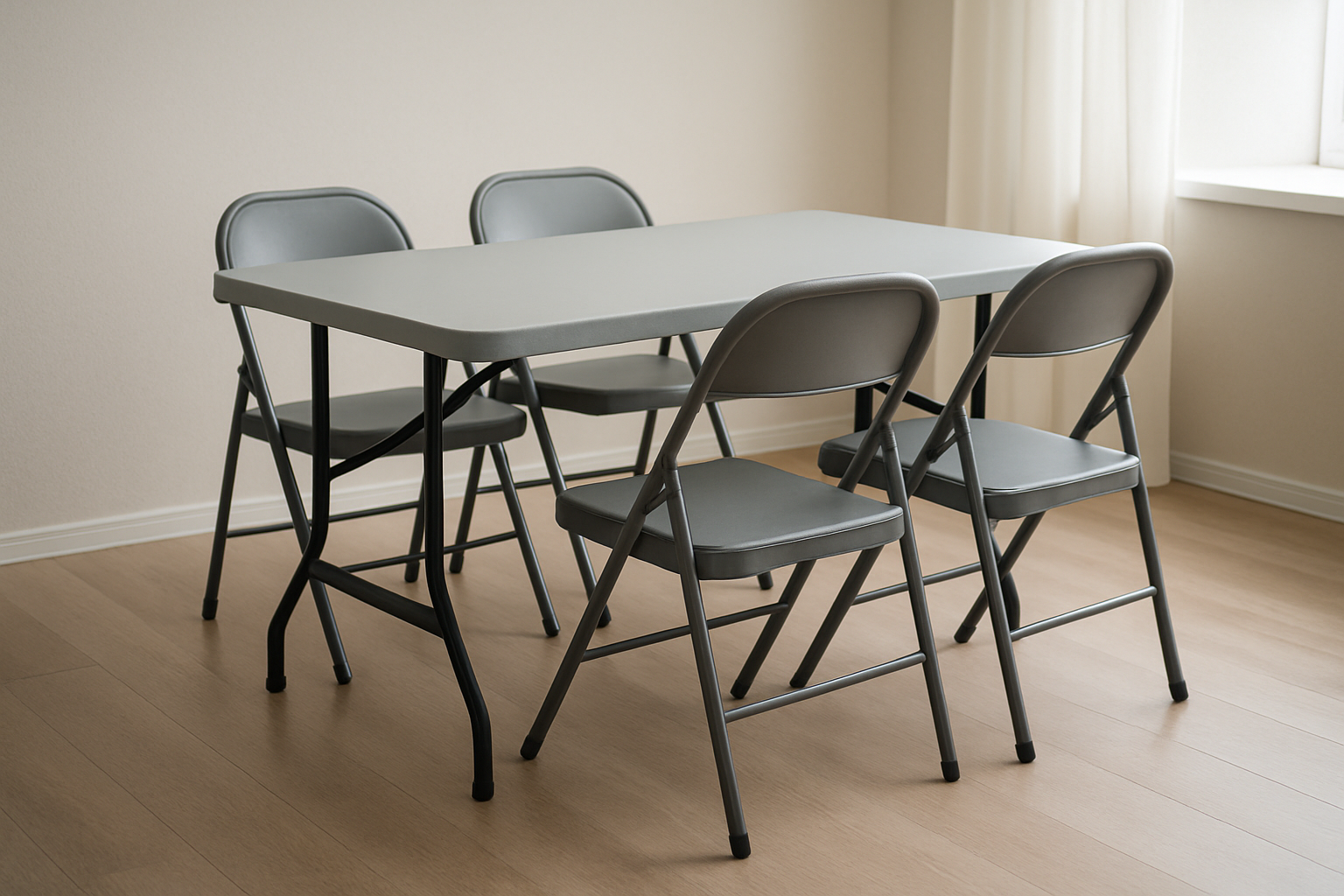
Here is the practical sequence to get a great match every time. First, measure your table height in cm (centimeters). Second, note the tabletop overhang and any lower crossbars that might hit your knees. Third, shortlist chairs that deliver the right gap and a base wide enough for your terrain. Finally, decide on the feature mix: rigid armrests for stand-ups, mesh for hot climates, cup holders for game nights, and headrests for long fireside talks. If you are shopping online, look for published seat height and packed dimensions; if they are missing, that is a red flag. Camper Loadouts’ reviews prioritize these numbers, so you do not have to dig through marketing fluff while you compare fold chairs.
To “see” fit before you buy, try a quick mockup at home. Stack books to your target seat height and sit at your kitchen table. Do your forearms rest easily? Does your lower back feel supported at an estimated 100-105 degrees? For a low-table lounge setup, drop your seat height and notice how your hips open as the angle increases. Small comfort cues now prevent campsite frustrations later. And if you share camp with people of different heights, consider two chair heights and two table heights that still nest for packing. With thoughtful pairing, a family or friend group can enjoy custom comfort without increasing car chaos, and your fold chairs will finally act as the reliable backbone of your camp.
Troubleshooting: Fixes for Common Chair-and-Table Pain Points
Even good gear can misbehave in the field. If your chair wobbles, inspect the ground first; a flat rock under one foot often fixes it. Persistent sway usually points to loose hinge hardware; a small multi-tool can tighten it in seconds. For step-by-step fixes and upkeep, see our camping chair maintenance guide. If your thighs hit the table edge, raise the chair with a firmer seat or swap to a table with more under-clearance. If you sink into sand, add wide “mud feet” or place a cutting board under each foot. When backs ache, it is often a back-angle issue: a pillow at the lumbar curve can reset posture quickly. Camper Loadouts catalogs these fixes and helps you choose fold chairs that need fewer band-aids in the first place.
When packing gets tight, think in shapes, not just volumes. Thin, rectangular folds can slot beside totes; tubes fit into corners; square cases stack under cots. Group chairs with their partner table and store them near the camp kitchen bin for faster setup flow. Many campers report that a left-to-right load order in the trunk mirrors their camp setup path, shaving minutes off each transition. Efficient packing does not kill spontaneity; it creates it, because you waste less energy on logistics. With measured pack volume and setup time benchmarks in hand, you can treat your fold chairs as system components rather than random add-ons.
Expert Tips: Stretch Your Budget Without Sacrificing Comfort
Great seating does not have to be expensive if you buy to a system. Put your budget into the chairs you use most: dining for food-centric trips, lounge for fire-centric trips, platform chairs for fishing days. Then add universal upgrades that boost every sit: wide feet, a compact side table, and a small lumbar pillow. Mix materials smartly: one steel-frame director chair for sturdiness at camp, one aluminum-frame chair for portability on day trips. Choose fabrics with replaceable seats or covers to extend life as sun and sand take their toll. Camper Loadouts’ guides flag models with user-replaceable parts and hard-to-find specs, helping your fold chairs stay comfortable, stable, and serviceable for seasons.
Finally, consider building one piece yourself. A simple, folding low table sized to your lounge chairs can cost little and pay off every evening. Do-it-yourself (DIY) plans from Camper Loadouts include clearance targets and hinge options, so your table fits under armrests and packs flat. If you fish, a small, clamp-on tray can bring your lure box into easy reach, reducing repetitive twisting. These small tweaks compound. Over a summer, fewer fidgets and faster meals translate into more stories told and more casts thrown. That is the real return on a smart seating system anchored by well-matched fold chairs.
--
Your campsite is a system, and the right numbers make it sing. Choose seat and table geometry that supports you, pick reliable materials, and pack shapes that work together.
Imagine your next trip: chairs that lock into stable footing, a table that meets your forearms just right, and a setup that deploys in minutes so you can linger longer.
What could your weekends feel like if every sit felt natural and every meal lingered, simply because your fold chairs finally fit your table and the way you move?
Additional Resources
Explore these authoritative resources to dive deeper into fold chairs.
- Wholesale Folding Chairs for Sale | EventStable.com
- Folding Chairs in Folding Furniture - Walmart.com
Pair Fold Chairs and Tables with Camper Loadouts
Camper Loadouts’ chair and table pairing guides match chairs, tables, cots, and organizers for comfort, stability, and pack efficiency for outdoor enthusiasts, glampers, car campers, anglers, and anyone seeking comfort.
Related Articles

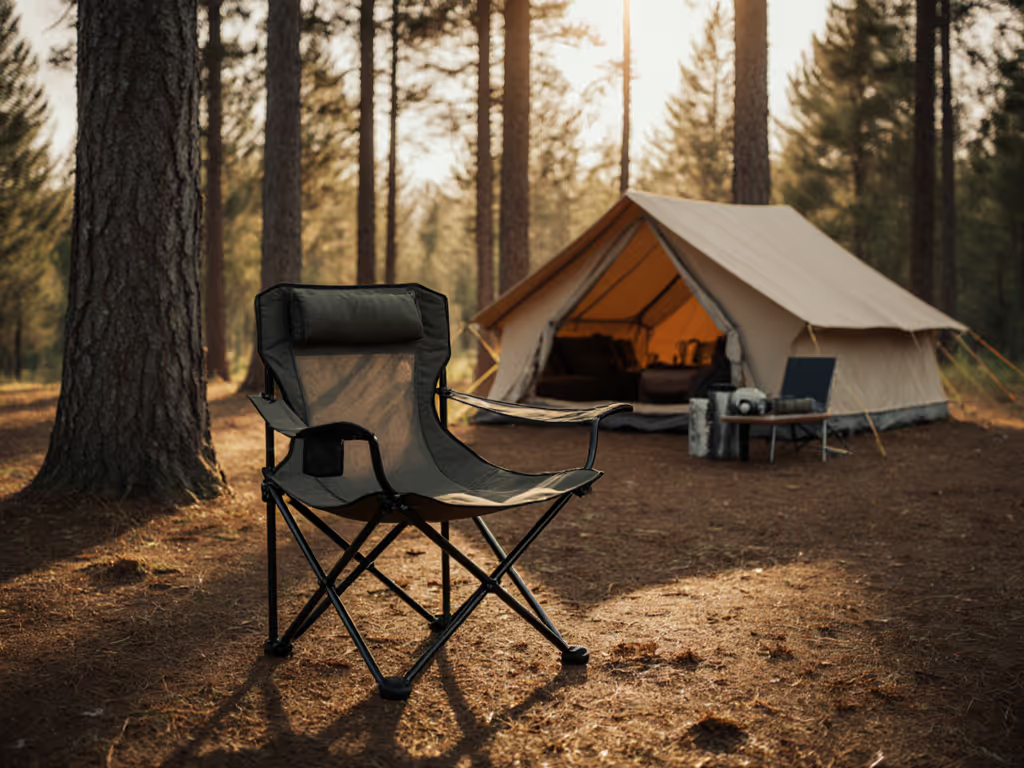
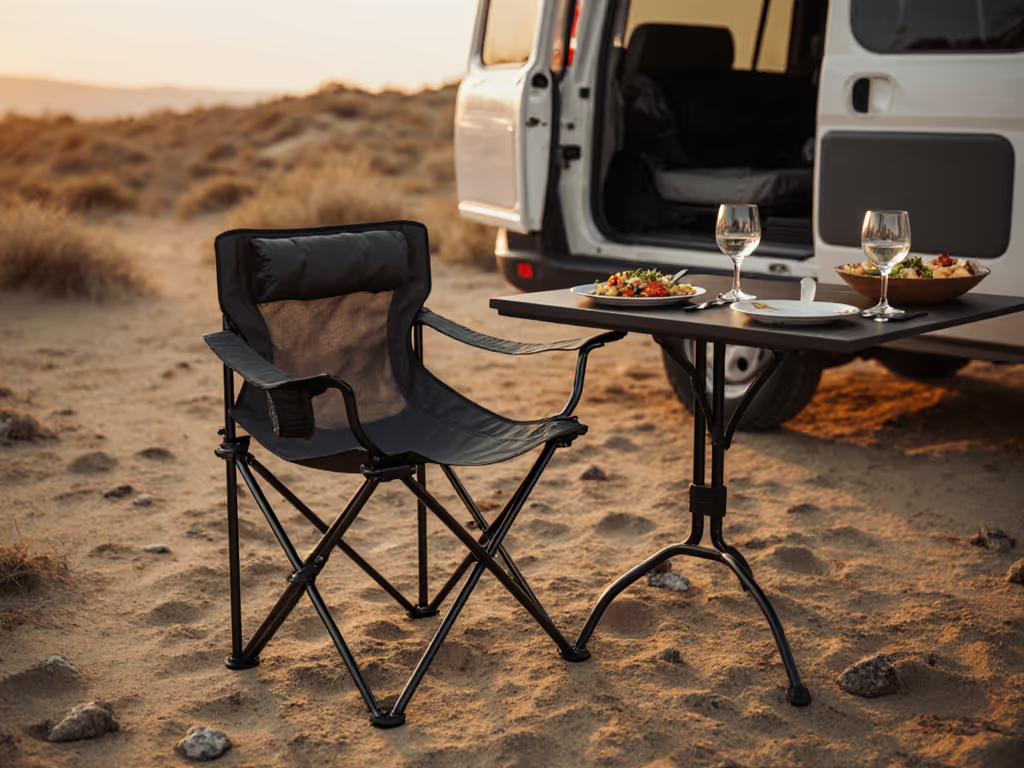
Car Camping Accessories: Ergonomic Chair Upgrades
Dial in seat-to-table geometry - not more padding - to turn rushed camp meals into relaxed, long-sit evenings. Get the exact measurements and simple fixes to match chair and table heights, stabilize on sand or rock, and keep groups comfortable from appetizers to dessert.
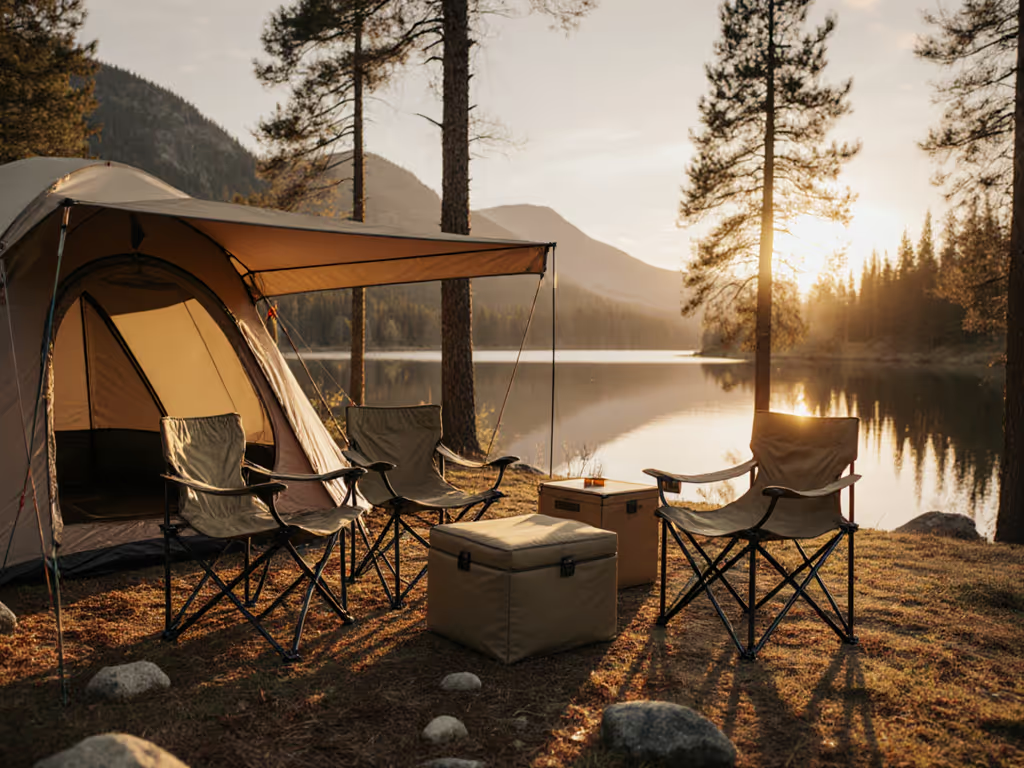
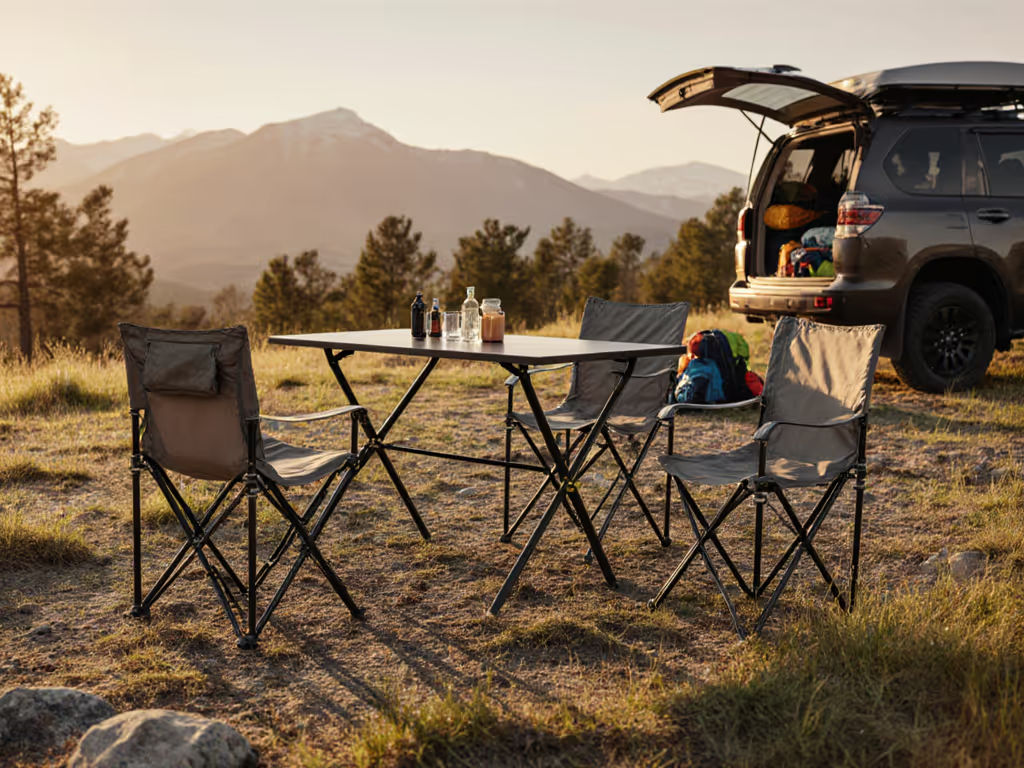
Best Camp Furniture Systems: Proven Value Sets
Build a cohesive camp furniture kit that fixes height mismatches, wobble, and packing chaos by prioritizing fit over brand. Use precise seat-to-table alignment, terrain adapters, and modular pairings like the Helinox ecosystem and an ALPS footprint to stay stable and scale from 2 to 6 without repeat purchases.
